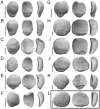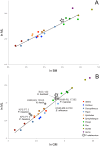The Middle Miocene ape Pierolapithecus catalaunicus exhibits extant great ape-like morphometric affinities on its patella: inferences on knee function and evolution
- PMID: 24637777
- PMCID: PMC3956854
- DOI: 10.1371/journal.pone.0091944
The Middle Miocene ape Pierolapithecus catalaunicus exhibits extant great ape-like morphometric affinities on its patella: inferences on knee function and evolution
Abstract
The mosaic nature of the Miocene ape postcranium hinders the reconstruction of the positional behavior and locomotion of these taxa based on isolated elements only. The fossil great ape Pierolapithecus catalaunicus (IPS 21350 skeleton; 11.9 Ma) exhibits a relatively wide and shallow thorax with moderate hand length and phalangeal curvature, dorsally-oriented metacarpophalangeal joints, and loss of ulnocarpal articulation. This evidence reveals enhanced orthograde postures without modern ape-like below-branch suspensory adaptations. Therefore, it has been proposed that natural selection enhanced vertical climbing (and not suspension per se) in Pierolapithecus catalaunicus. Although limb long bones are not available for this species, its patella (IPS 21350.37) can potentially provide insights into its knee function and thus on the complexity of its total morphological pattern. Here we provide a detailed description and morphometric analyses of IPS 21350.37, which are based on four external dimensions intended to capture the overall patellar shape. Our results reveal that the patella of Pierolapithecus is similar to that of extant great apes: proximodistally short, mediolaterally broad and anteroposteriorly thin. Previous biomechanical studies of the anthropoid knee based on the same measurements proposed that the modern great ape patella reflects a mobile knee joint while the long, narrow and thick patella of platyrrhine and especially cercopithecoid monkeys would increase the quadriceps moment arm in knee extension during walking, galloping, climbing and leaping. The patella of Pierolapithecus differs not only from that of monkeys and hylobatids, but also from that of basal hominoids (e.g., Proconsul and Nacholapithecus), which display slightly thinner patellae than extant great apes (the previously-inferred plesiomorphic hominoid condition). If patellar shape in Pierolapithecus is related to modern great ape-like knee function, our results suggest that increased knee mobility might have originally evolved in relation to enhanced climbing capabilities in great apes (such as specialized vertical climbing).
Conflict of interest statement
Figures





References
-
- Moyà-Solà S, Köhler M, Alba DM, Casanovas-Vilar I, Galindo J (2004) Pierolapithecus catalaunicus, a new Middle Miocene great ape from Spain. Science 306: 1339–1344. - PubMed
-
- Moyà-Solà S, Köhler M, Alba DM, Casanovas-Vilar I, Galindo J (2005) Response to comment on “Pierolapithecus catalaunicus, a new Middle Miocene great ape from Spain”. Science 308: 203d. - PubMed
-
- Casanovas-Vilar I, Alba DM, Moyà-Solà S, Galindo J, Cabrera L, et al. (2008) Biochronological, taphonomical and paleoenvironmental background of the fossil great ape Pierolapithecus catalaunicus (Primates, Hominidae). J Hum Evol 55: 589–603. - PubMed
-
- Almécija S, Alba DM, Moyà-Solà S (2009) Pierolapithecus and the functional morphology of Miocene ape hand phalanges: paleobiological and evolutionary implications. J Hum Evol 57: 284–297. - PubMed
-
- Susanna I, Alba DM, Almécija S, Moyà-Solà S (2010) The lumbar vertebrae of the Middle Miocene stem great ape Pierolapithecus catalaunicus (Primates: Hominidae). Am J Phys Anthropol 141 S50: 227.
Publication types
MeSH terms
LinkOut - more resources
Full Text Sources
Other Literature Sources
Research Materials
Miscellaneous

